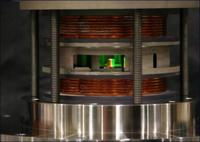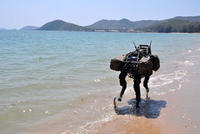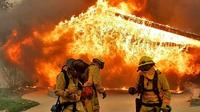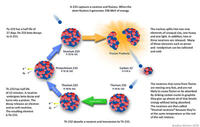-
Limiting world trade unlikely to reduce CO2 emissions
The United States emits less CO2 in the production of its exports than is contained in its imports, simply because it imports more than it exports; only about 20 percent of CO2 transfers from China into the United States can be traced back to the fact that China is in effect relatively more specialized in the production of dirty goods; interventions in world trade, like CO2 tariffs, would probably have only a small impact on global emissions
-
-
Microstructural improvements enhance material properties
DARPA merges structural engineering principles with new fabrication technologies to demonstrate microstructural control of materials at the micron level; the ultimate objective of the agency’s Materials with Controlled Microstructural Architecture (MCMA) program is to be able to develop materials in the future with properties tailored to meet specific mission requirements
-
-
U.S. models underestimates costs of carbon pollution
Model used by government all but ignores economic damages that climate change will inflict on future generations; two economists argue that when these costs are factored in, the real benefits of carbon reduction range from 2.6 to more than 12 times higher than the government’s estimate
-
-
Threat-recognition technology incorporates mind, machine

For soldiers operating in the field, the ability to detect threats from standoff distances can be life-saving; when advanced radar and drone coverage is not available, soldiers typically rely on their own vision to scan their surroundings; DARPA links human brainwaves, improved sensors, and cognitive algorithms to improve target detection
-
-
Sequestration would result in draconian cuts in biological, medical research
The Federation of American Societies for Experimental Biology says that sequestration would result in draconian cuts in biological and medical research; the National Institutes of Health (NIH) would be reduced by $2.529 billion, the National Science Foundation would lose $586 million, and the Department of Energy Office of Science would be cut by $400 million
-
-
New issues of the Journal of Homeland Security Education is available online
The latest issue of the Journal of Homeland Security Education is out; it contains a number of articles relevant to the teaching of homeland security practices, which is now one of the top ten majors for undergraduates in the United States
-
-
Harvesting fuel for nuclear reactors from the sea

Uranium floats in Earth’s oceans in trace amounts of just 3 parts per billion. It is not much, but it adds up; combined, our oceans hold up to 4.5 billion tons of uranium — potentially enough to fuel the world’s nuclear power plants for 6,500 years; researchers propose ways to harvest this uranium
-
-
Dry-run experiments confirm key aspect of Sandia nuclear fusion concept

Magnetically imploded tubes called liners, intended to help produce controlled nuclear fusion at scientific “break-even” energies or better within the next few years, have functioned successfully in preliminary tests, according to researchers
-
-
Four-legged “pack mule” robots demonstrate their capabilities

Two completed prototype robotic “pack mules” exhibit reduced noise, new gaits, and improved perception, the two functioning platforms have started to run through the paces similar to what they could one day experience carrying gear for a squad of Marines or Soldiers
-
-
DARPA’s legged robot beats Usain Bolt’s speed record

Usain Bolt, Olympic gold medalist and world record-holder sprinter, set the world speed record for a human in 2009 when he reached a peak speed of 27.78 mph for a 20-meter split during the 100-meter sprint; DARPA’s Cheetah robot, already the fastest legged robot in history, bested Bolt recently by clocking at 28.3 mph for a 20-meter split
-
-
U.K.’s first research institute to investigate the science of cyber security
A new U.K. academic research institute, aiming to improve understanding of the science behind the growing cybersecurity threat, was announced last week; GCHQ, the U.K. intelligence agency, says that the institute, which is funded by a £3.8 million grant, is part of a cross-government commitment to increasing the U.K. academic capability in all fields of cybersecurity
-
-
Wildfires have both positive and negative economic impacts

Wildfires disrupt the lives of workers, employers, and families, and lead to longer-term instability in local labor markets, but on the flip side of the coin, countywide employment and wages increase in some sectors during the wildfires, often mitigating the short-term employment disruptions wildfires cause
-
-
Verizon’s all-hazard approach to disaster preparation
September is National Preparedness Month in the United States, but Verizon saysits Business Continuity and Emergency Management teams are busy every day of the year monitoring, preparing, and responding to weather-related and man-made events throughout the world; there are 193 member states in the UN, and the company’s BCEM teams are operating in 150 of them and in more than 2,700 cities
-
-
Thorium to play limited role in U.K. future power supply

Worldwide, there has for a long time been a sustained interest in the thorium fuel cycle and presently there are several major research initiatives which are either focused specifically on the thorium fuel cycle or on systems which use thorium as the fertile seed instead of U-238; the U.K. National Nuclear Laboratory examined the topic and concluded that thorium has theoretical advantages but that these benefits are often overstated; as a result, thorium fuel cycle at best has only limited relevance to the United Kingdom as a possible alternative plutonium disposition strategy and as a possible strategic option
-
-
Regional, global food security effects of climate change to felt soon
Research shows that within the next ten years large parts of Asia can expect increased risk of more severe droughts, which will impact regional and possibly even global food security; on average, across Asia, droughts lasting longer than three months will be more than twice as severe in terms of their soil moisture deficit compared to the 1990-2005 period; China, Pakistan, and Turkey as the most seriously affected major producers of wheat and maize
-
More headlines
The long view
New Technology is Keeping the Skies Safe
DHS S&T Baggage, Cargo, and People Screening (BCP) Program develops state-of-the-art screening solutions to help secure airspace, communities, and borders
Factories First: Winning the Drone War Before It Starts
Wars are won by factories before they are won on the battlefield,Martin C. Feldmann writes, noting that the United States lacks the manufacturing depth for the coming drone age. Rectifying this situation “will take far more than procurement tweaks,” Feldmann writes. “It demands a national-level, wartime-scale industrial mobilization.”
How Artificial General Intelligence Could Affect the Rise and Fall of Nations
Visions for potential AGI futures: A new report from RAND aims to stimulate thinking among policymakers about possible impacts of the development of artificial general intelligence (AGI) on geopolitics and the world order.
Smaller Nuclear Reactors Spark Renewed Interest in a Once-Shunned Energy Source
In the past two years, half the states have taken action to promote nuclear power, from creating nuclear task forces to integrating nuclear into long-term energy plans.
Keeping the Lights on with Nuclear Waste: Radiochemistry Transforms Nuclear Waste into Strategic Materials
How UNLV radiochemistry is pioneering the future of energy in the Southwest by salvaging strategic materials from nuclear dumps –and making it safe.
Model Predicts Long-Term Effects of Nuclear Waste on Underground Disposal Systems
The simulations matched results from an underground lab experiment in Switzerland, suggesting modeling could be used to validate the safety of nuclear disposal sites.
